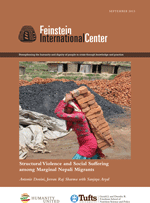Over the past decade, Nepal has witnessed a rapid process of social transformation which has accelerated after the end of the “people’s war”. In this report, the third in our series on change in Nepal, we look at migration, both internal and external, and how it affects the livelihoods of the poorer segments of the population. Mobility ranges from commuting for day labor to nearby areas and seasonal mobility to towns and cities or across the border to India, to organized migration to the Gulf, Southeast Asia, and beyond. Migration has become a significant and increasing part of the rural political economy. Our research documents the social suffering among migrants and locates their experiences in the wider context of social transformation in Nepal. It is based on in-depth interviews with the subjects themselves in different settings including cities like Kathmandu (brick kilns and the service, manufacturing, and construction sectors), towns and rural areas in Nepal (service and construction sectors), India (domestic work, service sector, etc.), the Gulf States (construction, agriculture, and domestic workers) and other sites where various forms of exploitative, bonded labor and trafficking practices are widespread.
Building on our earlier research, we find that mobility of labor has not necessarily meant more freedom for poorer migrants, although the idea of freedom appears to be driving much of the out-migration from rural Nepal. While migration has certainly opened up opportunities for cash income, the nature of work and working conditions have often resulted in social dislocation, humiliation, debt entrapment, social suffering, and structural violence. This highlights an apparent contradiction: migrants leave their villages because of their redundancy in the rural-agrarian labor processes and because of the attraction that modernity has to offer in the cities and towns, but they are constantly driven back to their village because of the transient and time-bound nature of their mobility. Thus, the identity of the migrant remains attached to the village even if the working sites and sectors are “modern” and urban.
For our earlier work on social transformation and changing labor relations in rural Nepal, see:
Towards a “Great Transformation”? and From Subjects to Citizens?







